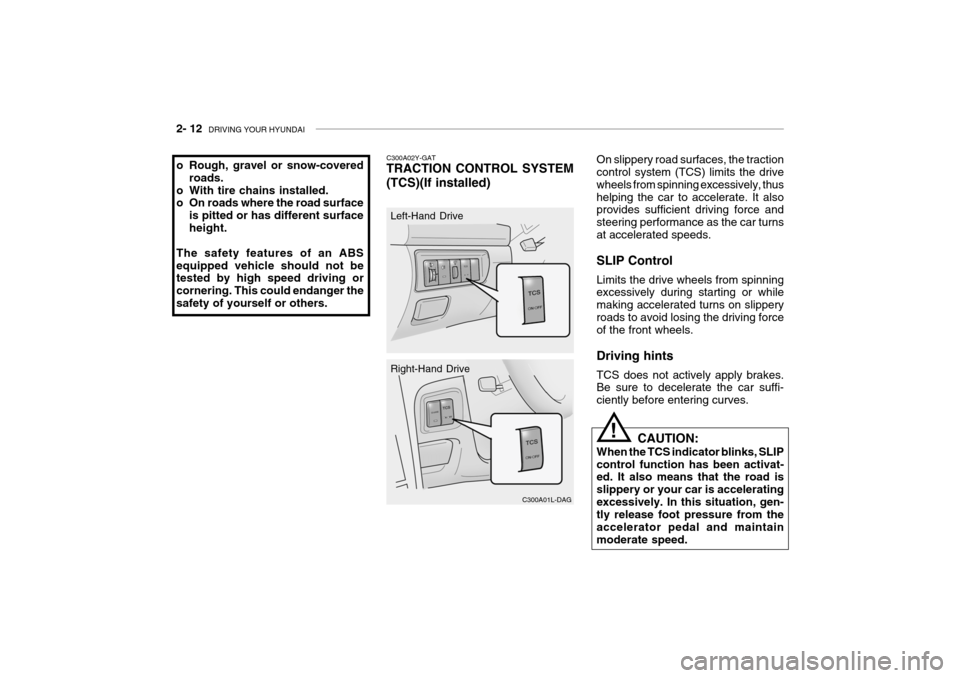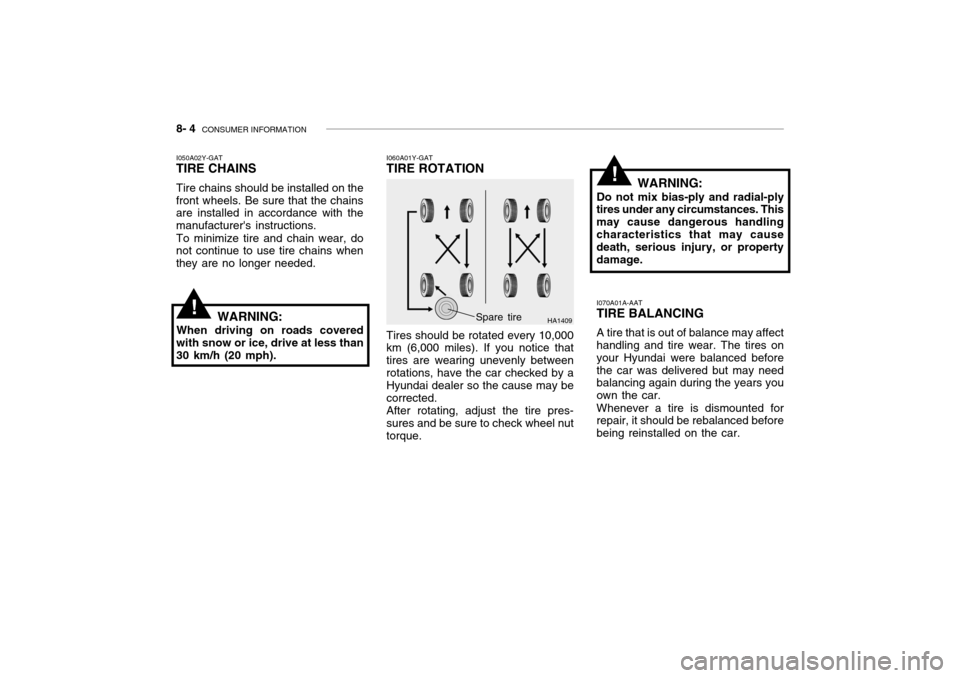snow chains Hyundai Grandeur 2004 Owner's Manual
[x] Cancel search | Manufacturer: HYUNDAI, Model Year: 2004, Model line: Grandeur, Model: Hyundai Grandeur 2004Pages: 235, PDF Size: 6.64 MB
Page 145 of 235

2- 12 DRIVING YOUR HYUNDAI
On slippery road surfaces, the traction control system (TCS) limits the drive wheels from spinning excessively, thushelping the car to accelerate. It also provides sufficient driving force and steering performance as the car turnsat accelerated speeds. SLIP Control Limits the drive wheels from spinning excessively during starting or while making accelerated turns on slipperyroads to avoid losing the driving force of the front wheels. Driving hints TCS does not actively apply brakes. Be sure to decelerate the car suffi- ciently before entering curves.
CAUTION:
When the TCS indicator blinks, SLIPcontrol function has been activat- ed. It also means that the road is slippery or your car is acceleratingexcessively. In this situation, gen- tly release foot pressure from the accelerator pedal and maintainmoderate speed.
C300A01L-DAG
Right-Hand Drive
C300A02Y-GAT TRACTION CONTROL SYSTEM (TCS)(If installed)
C300A01L
Left-Hand Drive
!
o Rough, gravel or snow-covered
roads.
o With tire chains installed.
o On roads where the road surface
is pitted or has different surface height.
The safety features of an ABSequipped vehicle should not be tested by high speed driving or cornering. This could endanger thesafety of yourself or others.
Page 149 of 235

2- 16 DRIVING YOUR HYUNDAI
C160C01A-AAT Use High Quality Ethylene Glycol Coolant Your Hyundai is delivered with high quality ethylene glycol coolant in the cooling system. It is the only type of coolant that should be used because ithelps prevent corrosion in the cooling system, lubricates the water pump and prevents freezing. Be sure to replaceor replenish your coolant in accor- dance with the maintenance schedule in Section 5. Before winter, have yourcoolant tested to assure that its freez- ing point is sufficient for the tempera- tures anticipated during the winter.
C160A01A-AAT WINTER DRIVING The more severe weather conditions of winter result in greater wear andother problems. To minimize the prob- lems of winter driving, you should fol- low these suggestions: C160B01A-GAT Snowy or Icy Conditions To drive your vehicle in deep snow, it may be necessary to use snow tires or to install tire chains on your tires. If snow tires are needed, it is necessaryto select tires equivalent in size and type of the original equipment tires. Failure to do so may adversely affectthe safety and handling of your car. Furthermore, speeding, rapid accel- eration, sudden brake applications, andsharp turns are potentially very haz- ardous practices. During deceleration, use engine brak-ing to the fullest extent. Sudden brake applications on snowy or icy roads may cause skids to occur. You need tokeep sufficient distance between the vehicle in front and your vehicle. Also, apply the brake gently. It should be noted that installing tire chains on the tire will provide a greater driving force, but will not prevent side skids. NOTE: Tire chains are not legal in all prov- inces. Check province laws beforefitting tire chains.
C150A01A-AAT SMOOTH CORNERING Avoid braking or gear changing in cor- ners, especially when roads are wet. Ideally, corners should always be takenunder gentle acceleration. If you follow these suggestions, tire wear will be held to a minimum.
o Don't "lug" or "over-rev" the engine.
Lugging is driving too slowly in toohigh a gear resulting in the enginebucking. If this happens, shift to a lower gear. Over-revving is racing the engine beyond its safe limit.This can be avoided by shifting at the recommended speeds.
o Use your air conditioning sparingly. The air conditioning system is oper-ated by engine power so your fuel economy is reduced when you useit.
Page 151 of 235

2- 18 DRIVING YOUR HYUNDAI
C180A01A-AAT USE OF LIGHTS Check your lights regularly for correct operation and always keep them clean.When driving during the day in condi- tions of poor visibility, it is helpful to drive with headlights on low beam.This enables you to be seen as well as to see.
C190A01A-GAT TRAILER OR VEHICLE TOWING If you are considering towing with your car, you should first check with your Province Department of Motor Vehicles
to determine their legal requirements.Since laws vary from province to prov- ince the requirements for towing trail- ers, cars, or other types of vehicles orapparatus may differ. Ask your Hyundai dealer for further details before towing.
C170A01A-AAT HIGH SPEED MOTORING Pre-Trip Inspections 1. Tires: Adjust the tire inflation pressures to specification. Low tire inflation pres-sures will result in overheating and possible failure of the tires. Avoid using worn or damaged tireswhich may result in reduced traction or tire failure. NOTE: Never exceed the maximum tire in- flation pressure shown on the tires. 2. Fuel, engine coolant and engine oil: High speed travel consumes more fuel than urban motoring. Do not forget tocheck both engine coolant and engine oil. 3. Drive belt: A loose or damaged drive belt may result in overheating of the engine.
C160K01A-AAT Carry Emergency Equipment Depending on the severity of the weather where you drive your car, you should carry appropriate emergency equipment. Some of the items youmay want to carry include tire chains, tow straps or chains, flashlight, emer- gency flares, sand, a shovel, jumpercables, a window scraper, gloves, ground cloth, coveralls, a blanket, etc.
C160J01A-AAT Don't Let Ice and Snow Accumu- late Underneath Under some conditions, snow and ice can build up under the fenders and interfere with the steering. When driv-ing in severe winter conditions where this may happen, you should periodi- cally check underneath the car to besure the movement of the front wheels and the steering components is not obstructed.
Page 221 of 235

8. CONSUMER INFORMATION
Vehicle Identification Number (VIN) .............................................. 8-2
Engine Number .............................................................................. 8-2
Recommended Inflation Pressures ................................................ 8-2
Snow Tires ...................................................................................... 8-3
Tire Chains ..................................................................................... 8-4
Tire Rotation ................................................................................... 8-4
Tire Balancing ................................................................................. 8-4
Tire Traction ................................................................................... 8-5
When to Replace Tires .................................................................. 8-5
Spare Tire and Tools ..................................................................... 8-5
8
Page 224 of 235

8- 4 CONSUMER INFORMATION
I060A01Y-GAT TIRE ROTATION Tires should be rotated every 10,000 km (6,000 miles). If you notice that tires are wearing unevenly between
rotations, have the car checked by a Hyundai dealer so the cause may be corrected.After rotating, adjust the tire pres-sures and be sure to check wheel nuttorque. HA1409
Spare tire WARNING:
Do not mix bias-ply and radial-ply
tires under any circumstances. This may cause dangerous handlingcharacteristics that may cause death, serious injury, or property damage.
!
I070A01A-AAT TIRE BALANCING A tire that is out of balance may affect handling and tire wear. The tires on your Hyundai were balanced beforethe car was delivered but may need balancing again during the years you own the car. Whenever a tire is dismounted for repair, it should be rebalanced before being reinstalled on the car.
I050A02Y-GAT
TIRE CHAINS
Tire chains should be installed on the
front wheels. Be sure that the chains are installed in accordance with the manufacturer's instructions.
To minimize tire and chain wear, do
not continue to use tire chains whenthey are no longer needed.!WARNING:
When driving on roads covered with snow or ice, drive at less than30 km/h (20 mph).
Page 234 of 235

INDEX 10- 5
Adjusting seat forwar d and rearward..................... 1-14
Adjusting seatback angle ................. ...................... 1-15
Seat cushion height adjustment............................ 1-15
Power Steering Fluid Level ............................. ..........6-24
R
Rear Seat Fold Down ............................................. 1-18 Rear Window Defroster Switch .................... 1-54 ~ 1-55
Replacement of light bulbs .......................................6-26
SSeat Front ........................................................... 1-11 ~ 1-15
Seat Warmer ............................................................. 1-17
Seat Belts 3-Point system ........................................... 1-21 ~ 1-23
Adjustable height ........................................ 1-21 ~ 1-22 Adjusting your seat be lt .........................................1-22
Care of seat belts .................................................. 1-20
Precautions ............................................................ 1-19
Spark Plugs ................................................... 6-10 ~ 6-11
Spectacle Case ......................................................... 1-63
Speedometer ............................................................. 1-47
Starting Procedure ...................................................... 2-4
Steering Wheel Freeplay .................. ........................ 6-19
Steering Wheel Electric T ilt and Telescopic ............. 1-75
Steering Wheel Tilt Lever .............. ...........................1-73
Stereo Radio Operation (H940B, H940A)
......................................... 1-97 ~ 1-99, 1-105 ~ 1-107
Stereo Sound System ................................... 1-95 ~ 1-96 Sun Visor
.................................................................. 1-73
Sunroof .......................................................... 1-59 ~ 1-61
T Tachometer ............................................................... 1-48
Theft-Alarm system ........................................... 1-8 ~ 1-9Tires Balancing .................................................................. 8-4
Chains ...................................................................... 8-4
If you have a flat ti re ................................... 3-5 ~ 3-10
Information ............................................................... 8-2
Pressure ......................................................... 8-2 ~ 8-3
Replacement ............................................................ 8-5
Rotation .................................................................... 8-4
Snow tires ................................................................ 8-3
Spare tire ................................................................. 3-5
Traction .................................................................... 8-4
Towing
A trailer (or vehicle) ................................... 2-18 ~ 2-21
Emergency ............................................................. 3-12
If your car must be towed ......................... 3-10 ~ 3-12
Traction Control System ............................... 2-12 ~ 2-13
Transaxle Automatic ..................................................... 2-7 ~ 2-11Automatic transaxle fluid checking ............ 6-14 ~ 6-15
Manual ..................................................................... 2-5
Manual transaxle Oil che cking ................... 6-13 ~ 6-14
Trip Computer ............................................... 1-55 ~ 1-56
Trip Odometer ............................................... 1-48 ~ 1-49
Trunk Lid ....................................................... 1-66 ~ 1-68